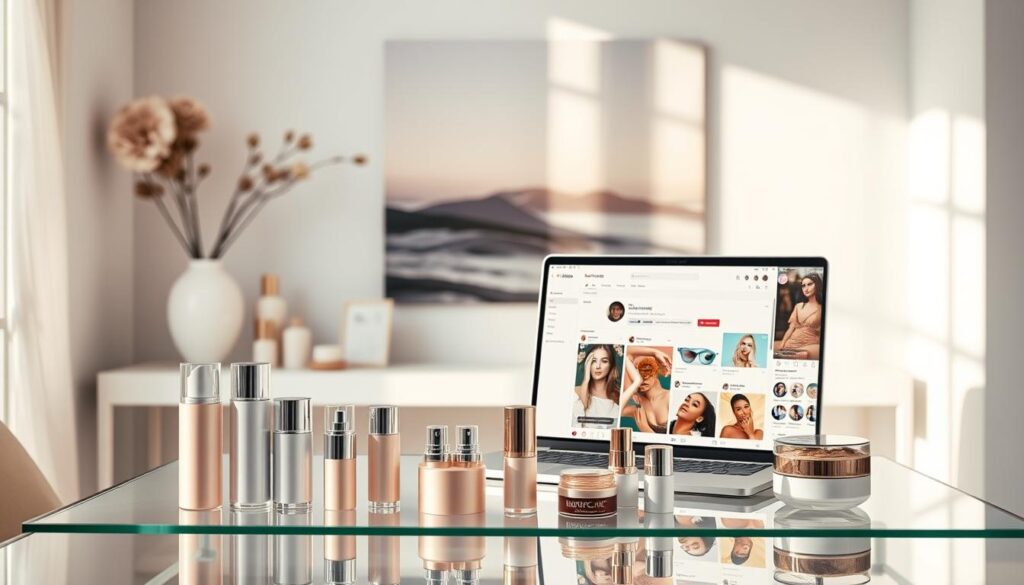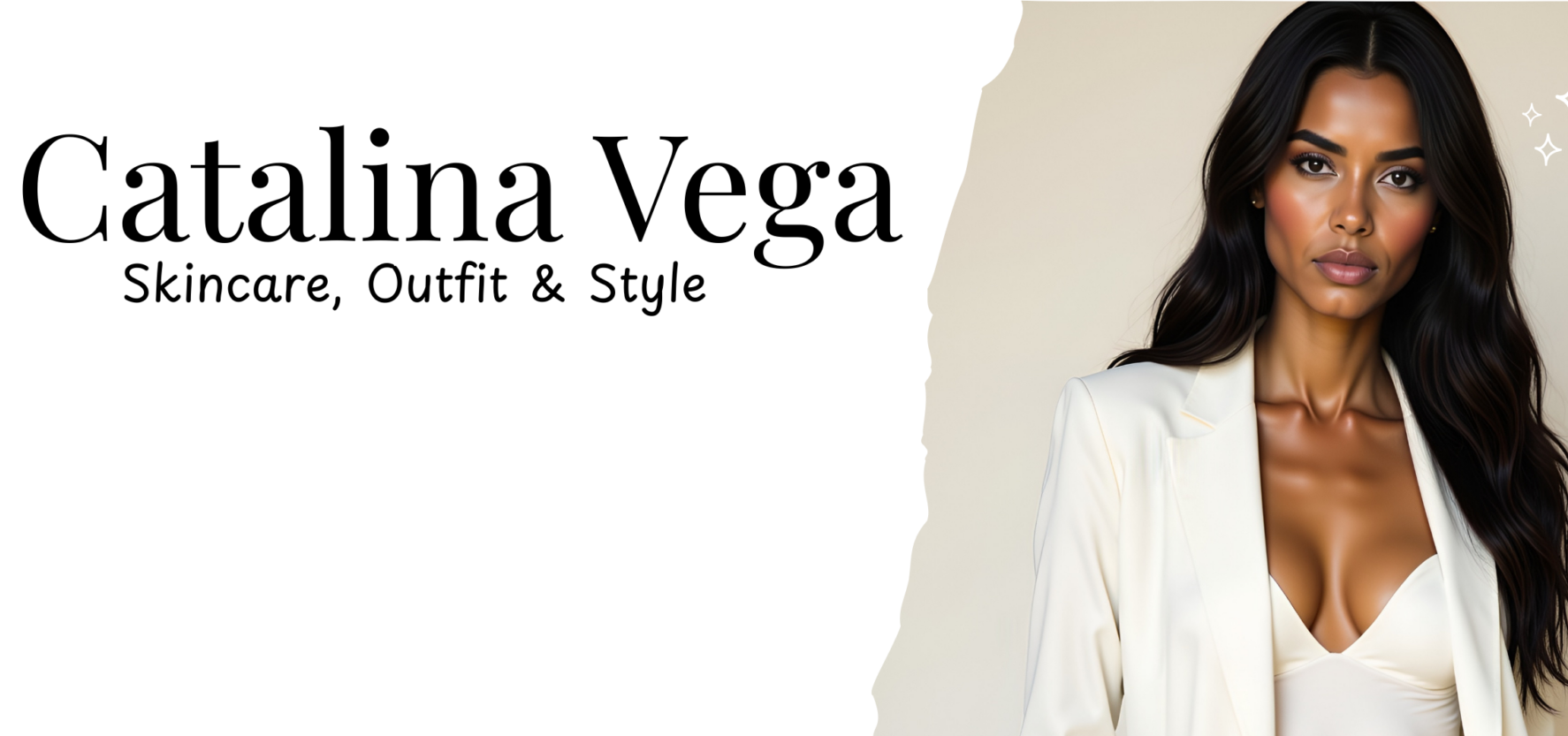In today’s digital world, standing out on social media is more important than ever. For small beauty brands, this means creating content that grabs attention and tells a story. High-quality visuals, like clean lifestyle images and creative ad graphics, can make all the difference.

Why does this matter? Because your audience is scrolling fast. A strong brand story paired with eye-catching visuals can stop them in their tracks. Whether it’s a white background shot or a vibrant lifestyle image, your content needs to speak directly to your audience.
In this guide, we’ll explore proven strategies to elevate your marketing efforts. From influencer partnerships to engaging video content, we’ll cover it all. Let’s dive in and help your brand shine!
Key Takeaways
- High-quality visuals are essential for grabbing attention on social media.
- A strong brand story helps connect with your audience.
- White background shots and lifestyle images are effective tools.
- Influencer partnerships can boost your reach and credibility.
- Video content is a powerful way to engage your audience.
Understanding the Beauty Industry Landscape
Social media has reshaped how the beauty sector connects with its audience. The industry is booming, with ecommerce sales reaching $113.77 billion in recent years. This growth is fueled by shifting consumer behavior and the rise of platforms like Instagram and TikTok.
Market Trends in the Beauty Sector
Current trends show a focus on authenticity and inclusivity. Consumers now prefer brands that align with their values. Clean beauty and sustainable products are gaining traction. Social media plays a huge role in spreading these trends.
Smaller brands are leveraging these shifts to compete with established names. By focusing on niche markets and personalized experiences, they’re carving out their space. Platforms like TikTok allow them to reach a younger, engaged audience.
Competitive Analysis for Small Brands
Understanding the competition is crucial. Smaller brands often use data to identify gaps in the market. For example, Revolution Beauty and Glossier have succeeded by targeting specific customer needs.
Quantitative data, like sales numbers and follower counts, provides insights. But qualitative factors, such as brand perception, are equally important. A strong social media presence can boost credibility and visibility.
Here’s what small brands should focus on:
- Identifying unique selling points.
- Engaging with their audience through authentic content.
- Monitoring competitors to adapt strategies.
By combining data-driven insights with creative storytelling, smaller brands can thrive in this competitive landscape.
Defining Your Unique Brand Identity
Your identity sets the tone for how your audience perceives you. In a world filled with endless choices, standing out requires more than just great products. It’s about creating a recognizable aesthetic and core values that resonate with your audience.
Crafting a Recognizable Aesthetic
Visuals are the first thing your audience notices. Think about how Fenty Beauty uses bold, inclusive imagery to reflect its mission. Your content—whether it’s product photos or packaging—should tell your story. Consistency in colors, fonts, and style helps build recognition.
For example, Glossier’s minimalist aesthetic aligns perfectly with its focus on natural makeup and skincare. This approach not only attracts attention but also builds trust. Your visuals should communicate your values and make your audience feel connected.
Establishing Core Brand Values
Values are the heart of your identity. They guide your decisions and help you connect with your audience on a deeper level. Whether it’s sustainability, inclusivity, or innovation, your values should shine through in everything you do.
Take Fenty Beauty’s commitment to diversity. It’s not just a selling point—it’s a core value that resonates with millions. By aligning your cosmetics and skincare offerings with your values, you create a loyal following that believes in what you stand for.
Effective Beauty brand marketing Tactics
Building trust and credibility is essential for any successful online presence. One of the most powerful ways to achieve this is by leveraging social proof and customer testimonials. When potential customers see real people endorsing your products, it creates a sense of authenticity that’s hard to ignore.
Leveraging Influencer Marketing
Partnering with influencers can significantly boost your reach and credibility. Micro-influencers, in particular, often have highly engaged audiences that trust their recommendations. When selecting influencers, focus on those who naturally align with your aesthetic and values. This ensures their endorsements feel genuine and resonate with your target audience.
Showcasing Customer Testimonials
Customer testimonials are another powerful tool. They provide real-life examples of how your products have made a difference. To gather testimonials, consider offering incentives for reviews or creating a dedicated hashtag for user-generated content. Once collected, showcase them prominently on your website and social media channels.
“Authentic endorsements from real customers can transform how potential buyers perceive your products.”
Creative Campaigns and Dynamic Content
Dynamic content and creative campaigns can amplify your message. For example, repurposing product photography into engaging posts or creating behind-the-scenes videos can captivate your audience. These strategies not only highlight your products but also tell a story that connects with your audience on a deeper level.
Here are some actionable steps to integrate these tactics:
- Identify influencers who align with your values and aesthetic.
- Encourage customers to share their experiences through reviews and testimonials.
- Develop creative campaigns that highlight your products in unique ways.
- Use dynamic content like videos and user-generated posts to engage your audience.
By combining these strategies, you can build a strong foundation of trust and credibility that drives long-term success.
Building a Robust Social Media Presence
Social media platforms like Instagram and TikTok are key to building meaningful engagement. To succeed, businesses need a mix of organic growth and paid advertising. These strategies work together to maximize reach and drive results.

Organic Growth Strategies on Instagram and TikTok
Organic growth starts with consistency. Posting daily keeps your audience engaged and builds trust. Experiment with different types of content, like video tutorials or behind-the-scenes clips, to see what resonates.
Hashtags and collaborations can also boost visibility. Use trending hashtags to join larger conversations. Partner with creators who align with your values to expand your reach.
Maximizing Paid Social Advertising
Paid advertising complements organic efforts by targeting specific audiences. Platforms like Instagram and TikTok offer advanced tools to refine your ads. Focus on video content, as it drives higher engagement and conversions.
Track your ad performance regularly. Adjust your strategy based on metrics like click-through rates and conversions. This ensures your budget is spent effectively.
Here’s a quick comparison of organic and paid strategies:
| Strategy | Pros | Cons |
|---|---|---|
| Organic Growth | Cost-effective, builds trust | Slower results, requires consistency |
| Paid Advertising | Quick results, precise targeting | Requires budget, ongoing optimization |
By combining these marketing strategies, you can create a powerful social media presence. Focus on engagement and continuous improvement to stay ahead in the competitive landscape.
Utilizing Influencer Partnerships for Authentic Engagement
Micro-influencers are reshaping the way small businesses engage with their communities. With highly engaged audiences and authentic content, they offer a personal touch that resonates deeply. Partnering with the right influencers can transform how your audience connects with your products.
Selecting the Right Micro-Influencers
Choosing the right influencers is crucial. Look for creators whose values and aesthetic align with yours. For example, Glossier has successfully partnered with micro-influencers who share their minimalist, natural vibe. This approach ensures authenticity and strengthens your message.
Here are some practical tips for identifying the perfect match:
- Analyze their audience demographics to ensure alignment with your target market.
- Review their content quality and engagement rates.
- Check for genuine interactions with their followers.
Maximizing Influencer Collaborations
There are several approaches to integrating influencer content into your strategy. One effective way is to co-create content that feels natural and authentic. For instance, behind-the-scenes videos or product unboxings can captivate your audience.
Here’s a quick guide to making the most of these partnerships:
| Strategy | Benefits |
|---|---|
| Co-Creation | Builds trust and authenticity |
| Exclusive Offers | Drives engagement and sales |
| User-Generated Content | Amplifies reach and credibility |
By following these tips, you can create meaningful connections with your audience. Remember, the key is to stay genuine and aligned with your values.
Harnessing the Power of Video Content
Video content has become a game-changer in connecting with audiences effectively. It’s no longer just an option—it’s a necessity for showcasing products in a way that’s both engaging and informative. Whether it’s a how-to tutorial or a product transformation, video brings your story to life.

Creating Engaging How-To Tutorials
How-to tutorials are a fantastic way to simplify complex techniques. They provide step-by-step guidance, making it easy for your audience to follow along. For example, a tutorial on applying a specific product can highlight its benefits while teaching a new skill.
Keep your videos concise and focused. Use clear visuals and a friendly tone to make the process relatable. This approach not only educates but also builds trust with your viewers.
Showcasing Product Transformations and Demos
Product transformations are a powerful way to demonstrate value. Before-and-after videos, for instance, visually highlight the impact of your products. These demos can be particularly effective when paired with real-time results.
Timing is key. Launching a video campaign that aligns with current trends can make your content feel relevant and timely. This strategy ensures your message resonates with your audience today.
Here are some tips for creating impactful video content:
- Focus on clear, high-quality visuals that showcase your products effectively.
- Plan your campaign to align with broader marketing goals.
- Use relatable scenarios to connect with your audience on a personal level.
By incorporating these strategies, you can create videos that not only inform but also inspire. Video content is a dynamic tool that, when used well, can elevate your message and drive meaningful engagement.
Leveraging User-Generated Content and Community Building
Building a loyal audience starts with empowering your customers to share their experiences. User-generated content (UGC) is a powerful tool that transforms customers into advocates. When people share their stories, it creates a sense of belonging and trust within your community.
Encouraging Customer Participation and Reviews
One of the best ways to boost engagement is by encouraging customers to share their experiences. Here’s how you can do it:
- Create a dedicated hashtag for customers to use when posting about your products.
- Offer incentives like discounts or giveaways for sharing reviews or photos.
- Feature customer content on your social media channels to show appreciation.
Glossier, for example, has mastered this approach. They frequently repost customer photos, creating a vibrant community of loyal fans. This not only boosts engagement but also serves as authentic social proof.
“When customers see their content featured, it builds trust and strengthens their connection to your products.”
Another effective strategy is integrating customer reviews into your website and social media. Highlighting real feedback adds credibility and helps potential buyers make informed decisions.
Here are some practical steps to amplify customer voices:
- Use Instagram Stories or TikTok to showcase customer testimonials.
- Create a dedicated section on your website for reviews and user photos.
- Engage with customers by responding to their posts and comments.
By leveraging these channels, you can create a thriving community that feels valued and heard. This approach not only drives engagement but also builds long-term loyalty.
Optimizing Visual Content for SEO
Visual content is a cornerstone of effective online strategies. From product photos to lifestyle images, every visual plays a role in how your audience perceives your offerings. But it’s not just about aesthetics—proper optimization ensures your visuals contribute to your SEO efforts and enhance your online presence.

Best Practices for Image Optimization
Start by optimizing file sizes to ensure fast loading times. Large files can slow down your website, negatively impacting user experience and search rankings. Tools like JPEG Optimizer or TinyPNG can help compress images without sacrificing quality.
Next, focus on alt text and file names. Use descriptive alt text that includes relevant keywords, such as skin or cosmetics, to improve accessibility and search visibility. Similarly, rename image files with target keywords instead of generic names like “IMG_1234.”
Here’s a quick checklist for image optimization:
- Compress files for faster loading times.
- Write descriptive alt text with relevant keywords.
- Use keyword-rich file names.
Maintaining Visual Consistency Across Channels
Consistency is key to building credibility. Whether it’s your website, Instagram, or TikTok, your visuals should reflect a unified aesthetic. This includes using consistent colors, fonts, and styles that align with your identity.
For example, if your advertising campaigns feature clean, minimalist visuals, ensure your social media posts follow the same theme. This creates a cohesive experience for your audience and reinforces your message.
“A consistent visual identity builds trust and makes your content instantly recognizable.”
Optimized visuals also support your advertising efforts. High-quality images and videos can capture attention and drive engagement, while proper SEO ensures they reach a wider audience. By combining technical optimization with creative consistency, you can elevate your online presence and build long-term credibility.
Strategies for Effective Campaign Execution
Effective campaign execution requires a blend of strategy and adaptability. It’s not just about launching a campaign—it’s about planning meticulously, monitoring performance, and refining tactics to achieve the best results. Whether your goal is to boost sales or enhance perceived quality, the right approach can make all the difference.
Planning and Analyzing Campaign Performance
Start by setting clear objectives. What do you want to achieve? Increased sales, higher engagement, or improved quality perception? Once your goals are defined, outline a step-by-step plan. This includes identifying your target audience, selecting the right channels, and creating content that resonates.
Data analytics plays a crucial role in monitoring performance. Use tools to track metrics like click-through rates, conversions, and customer feedback. This data helps you adjust tactics in real time, ensuring your campaign stays on track. For example, if a particular ad isn’t performing well, tweak the messaging or visuals to better align with your audience’s preferences.
Here’s a quick guide to planning and analyzing campaigns:
| Step | Action | Outcome |
|---|---|---|
| 1 | Set clear objectives | Defined goals for the campaign |
| 2 | Identify target audience | Tailored content and messaging |
| 3 | Monitor performance metrics | Real-time adjustments for better results |
Focus on elements that increase customer engagement. Interactive content, personalized offers, and timely follow-ups can make your campaign more effective. For instance, a well-timed email campaign with exclusive discounts can drive sales while enhancing the perceived quality of your offerings.
Customer feedback is invaluable. Use it to refine your strategies and improve future campaigns. Whether it’s through surveys, reviews, or social media comments, listening to your customers ensures your efforts align with their needs and expectations.
“A successful campaign is a dynamic process—plan carefully, monitor closely, and adapt quickly.”
By following these best practices, you can execute campaigns that deliver measurable results. Remember, the key is to stay flexible and responsive to both data and customer insights. This approach ensures your campaigns not only meet but exceed expectations.
Integrating Social Media Insights into Broader Branding
Social media insights are reshaping how businesses connect with their target audience. By analyzing data from platforms like Instagram and TikTok, companies can make informed decisions that align with consumer behavior. This approach shifts the focus from basic product promotion to building long-term trust.
Understanding your audience through social media analytics allows you to adapt your messaging in real time. For example, if a particular trend gains traction, you can quickly pivot your content to stay relevant. This agility is crucial in today’s fast-paced digital landscape.
Adapting to Trends and Consumer Feedback
One of the most effective ways to stay ahead is by monitoring trends and integrating consumer feedback into your strategy. Social media platforms provide a wealth of data on what resonates with your target audience. Use this information to refine your campaigns and ensure they align with current preferences.
Here are some practical steps to leverage social media insights:
- Analyze engagement metrics to identify popular content.
- Use polls and surveys to gather direct feedback from your audience.
- Adjust your messaging based on real-time data to maintain relevance.
For instance, if a specific product feature receives positive feedback, highlight it in your campaigns. This not only boosts business growth but also strengthens your connection with consumers.
“Adapting to consumer feedback ensures your messaging remains relevant and impactful.”
Case studies show that companies who integrate social media insights into their broader strategy see significant improvements in engagement and loyalty. By staying attuned to your audience’s needs, you can create a more holistic approach that drives long-term success.
Remember, the key is to connect social media insights with your overall business goals. This ensures your efforts are aligned and effective, helping you build a stronger, more trusted presence in the market.
Conclusion
Every product has a story that connects with its audience. From influencer partnerships to engaging video content, each strategy we’ve explored helps craft a powerful narrative. These methods not only highlight your products but also build trust and engagement.
Quality content, combined with a strategic approach, can elevate your presence. We encourage you to apply these tactics with care and attention to detail. Experiment with these ideas today and continuously refine your approach for the best results.
Our goal is to empower you with practical, expert advice. By focusing on storytelling and creativity, you can make your product stand out. Start implementing these strategies now and watch your efforts shine!




